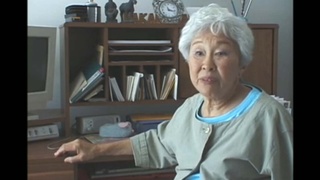Interviews
Tanforan Assembly Center
I remember that morning. We all assembled. Half a block from the house. It was a big crowd, and there was a line of buses on Bush Street. And they had soldiers. Military guards. And of course, at that age, my image of them, they were like monsters. Great big guys. And most of the nihonjins were all pretty much, much smaller. So the soldiers looked huge to me. And then we were given tags. I remember, it was kind of cold, drizzly, San Francisco weather. And then we, with our name tags, we boarded the buses. And as the buses pulled out, you look out the window and you see more of the Issei and Nisei, accumulating for the next bus, and they had the luggage and stuff all piled up.
Then it was, I can’t really remember the time of it. But the next thing you know, we were pulling up to Tanforan. I’ve never been there before because, you know, being a kid. A race track. And then we got off, and I remember seeing the grand stand. And then all these horse stables. But on the inner part of the, I guess you might say, Tanforan. The barracks were being built. But they were all pretty new.
We were one of the lucky ones that actually had a new barrack. But some of my earlier friends that went there, they were staying in the horse stables. I remember them saying that, when they arrived, the stench of the manure, from the horses, was just just terrible. And then, of course, they had horse flies flying around, and in the corner big cobwebs, you know.
And then, they had these army cots folded, kind of laying on the side there. So they would unfold the cots, and “Where’s the mattress?” They said, “See those sacks? You go out and there’s stacks of hay. So you just fill those sacks and that’s your mattress.” Can you imagine if you’re allergic or have allergies, to have to sleep on that. As well as the stench and the thing.
Date: August 26, 2015
Location: California, US
Interviewer: John Esaki
Contributed by: Watase Media Arts Center, Japanese American National Museum
Explore More Videos

Conditions of assembly centers
(1922–2014) Political and civil rights activist.

Visit to assembly centers by E. Stanley Jones
(1922–2014) Political and civil rights activist.

Her experience as a Japanese-American schoolchild in Oceanside, California, after the bombing of Pearl Harbor
(1924-2018) Artist and playwright.

Finding work in the assembly center
(b.1913) Kibei from California who served in the MIS with Merrill’s Marauders during WWII.

Making the decision to resist the draft
(b. 1923) Nisei from Washington. Resisted draft during WWII.

Discharged from the U.S. Army after Pearl Harbor
(b. 1918) Founder Azumano Travel

Closing the Japanese school and deportation (Spanish)
(b. 1932-2016) Peruvian painter

Death of sister in October 1942
(1915 - 2011) Nisei florist who resettled in New York City after WW II. Active in Japanese American civil rights movement

Living conditions in prison while serving time for resisting the draft
(b. 1925) Draft resister

Talking to children about decision to resist the draft during World War II
(b. 1925) Draft resister

Reflecting on Japanese Americans' response to incarceration
(b. 1925) Draft resister

Encountering a train full of Japanese Americans being transported to a concentration camp
(b. 1923) Chick sexer


Sneaking out of the Hastings Park camp during World War II
(b. 1928) Doctor. Former Chair of the Japanese Canadian Redress Foundation.

Government's permission to publish Japanese newspaper in Canada during World War II
(b. 1928) Doctor. Former Chair of the Japanese Canadian Redress Foundation.
